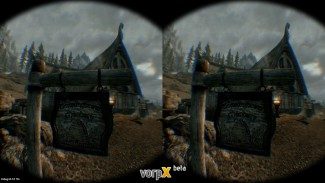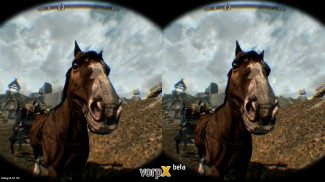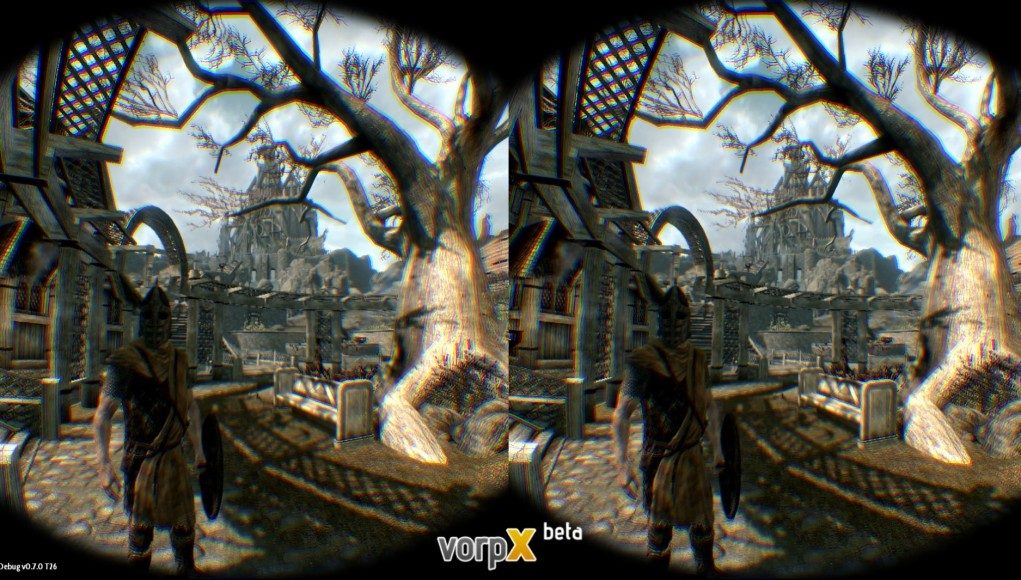It’s been a little while since VorpX, the 3D injection driver that allows you to use your Oculus Rift with many non-VR games, was released. VorpX was the first commercially available driver of its kind to be released to the public and allowed you to fire up Skyrim and wander the world in VR with head tracking and stereoscopic 3D. Now, VorpX developer Ralf Ostertag has announced that the next major release will add some cool new features, including support for the Oculus Rift DK2. 
For those who’ve received their Oculus Rift DK2’s, the dawning realisation that, out of the box, compatible content that supports the device is a little thin on the ground. This is improving quickly as more and more developers covert their code to the new SDK, but it’s a waiting game right now. The good news is, the next major release of VorpX adds support for Oculus’ latest VR headset, the DK2. This of course now means playing your games in VR on the DK2’s glorious new 1080p OLED display with low persistence and incredible contrast. As anyone who has spent any time with the DK1 and played games using VorpX on that device, this addition alone would make you sit up and take notice. However, the forthcoming build adds the following tasty options too.
Oculus Rift DK2 Positional Tracking
 Thus far limited to one title, The Elder Scrolls IV: Skyrim (2011), experimental support for one of the DK2’s new features optical positional tracking has been added. This means you can now lean, peer into, and dodge around the game’s epic fantasy world, adding even more immersion for Elder Scrolls fans. Check the video above for this new feature in action. More titles should follow Skyrim later with positional tracking support.
Thus far limited to one title, The Elder Scrolls IV: Skyrim (2011), experimental support for one of the DK2’s new features optical positional tracking has been added. This means you can now lean, peer into, and dodge around the game’s epic fantasy world, adding even more immersion for Elder Scrolls fans. Check the video above for this new feature in action. More titles should follow Skyrim later with positional tracking support.
Full Geometry Based Stereoscopic 3D Support for DX11 Titles
VorpX was the first to offer stereoscopic 3D support for DirectX11 based titles such as Bioshock: Infinite (2013) using an alternative method of stereo 3D rendering known as Z-Buffer 3D. This alternative method provides a very quick way to add depth to a scene, in particular large open spaces. The new version of VorpX unlocks Geometry based 3D, a more authentic and accurate method to describe a 3D world, to DX11 games. We’ve had a chance to experience this for ourselves and it works very well indeed. A jaunt through Bioshock: Infinite was particularly impressive with expansive scenes and in particular close proximity objects rendered with more solidity, accuracy, and depth.
Apply Optimal Game Configs From VorpX
 The whole point of VorpX is that you’re adding VR support to a game that currently has none. This often means, in order to get the optimal experience from the game in question, you’ll need to dive into config files to tweak settings such as FOV. The forthcoming version of VorpX contains a feature to apply the most common of these settings from the VorpX configuration utility. A good example is Mirror’s Edge (2008), which requires key bindings in order to switch the in-game FOV. Select the game profile within VorpX’s control panel, hit apply and those settings are automatically engaged for you with no requirements for digging around in your profile directories. This is great user experience enhancement and once that will hopefully save a lot of scratched heads and frustration. In addition to the above, the forthcoming version of VorpX adds the following headline features:
The whole point of VorpX is that you’re adding VR support to a game that currently has none. This often means, in order to get the optimal experience from the game in question, you’ll need to dive into config files to tweak settings such as FOV. The forthcoming version of VorpX contains a feature to apply the most common of these settings from the VorpX configuration utility. A good example is Mirror’s Edge (2008), which requires key bindings in order to switch the in-game FOV. Select the game profile within VorpX’s control panel, hit apply and those settings are automatically engaged for you with no requirements for digging around in your profile directories. This is great user experience enhancement and once that will hopefully save a lot of scratched heads and frustration. In addition to the above, the forthcoming version of VorpX adds the following headline features:
- 15 more games supported, more to follow soon
- Reduced head tracking lag in many DX9 games with VSync enabled
- Simplified setup (selecting the correct eye cups is enough in most cases)
- 75% Reduced watcher CPU usage
- 15% Faster pixel shader
Apart from that there are about 50 smaller additions and bugfixes included too, according to developer Ralf Ostertag. Other than that, Ostertag has worked hard to address one of the niggles users’ found fault with upon VorpX’s initial release; product registration, which was initially a manual process, has now been mostly automated. Ostertag tells Road to VR, “Usually this is a matter of minutes now. In some cases authorizations still have to be done manually, but 99% of all requests are automatically answered within minutes.” Existing VorpX owners will be able to upgrade to the latest version when it’s released.
Previous licenses are still valid, and will continue to work without any issues. Upgrades are issued automatically, similar to how the Steam update process works. VorpX checks for updates on startup. In case someone’s PC is behind a firewall that does forbid that, the original web installer that was downloaded after the purchase can be used for a manual update.
When we asked when to expect the new version of VorpX with Oculus Rift DK2 support, we get a one word answer: “Soon ;)”. Rest assured we’ll let you know the moment we know more. Meanwhile, we’ve got access to an early DK2 enabled version and are putting it through its paces to bring you some new videos and our impressions very soon. Meanwhile, if you’d like to grab a copy of VorpX ahead of the new version release, you can do that and support Road to VR by purchasing via our VorpX portal here. Full Disclosure: Road to VR has an affiliate agreement with VorpX.







